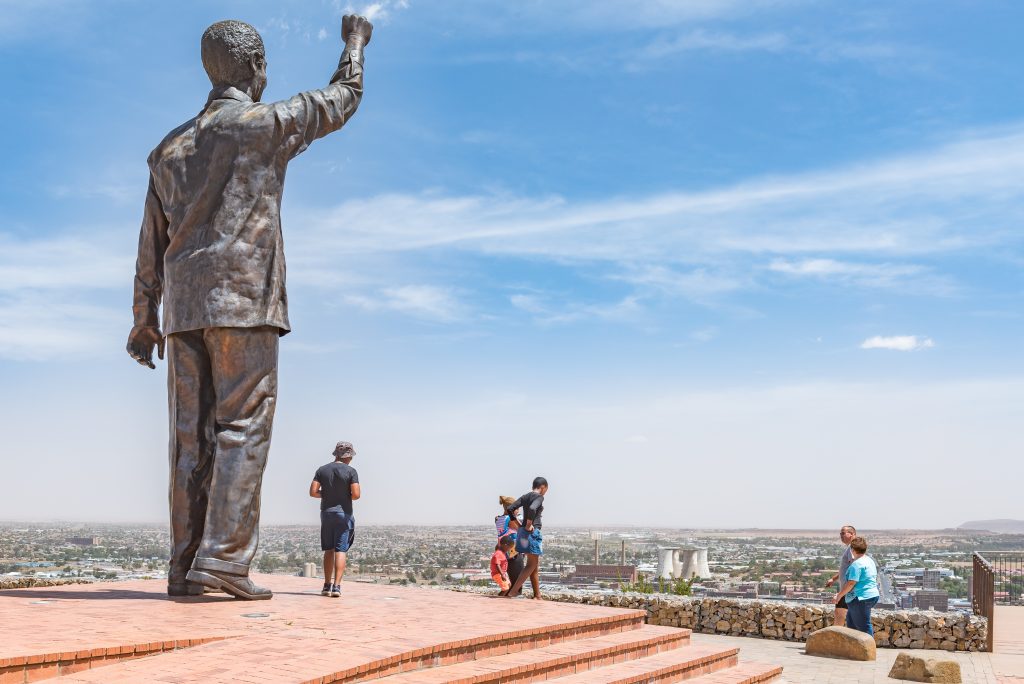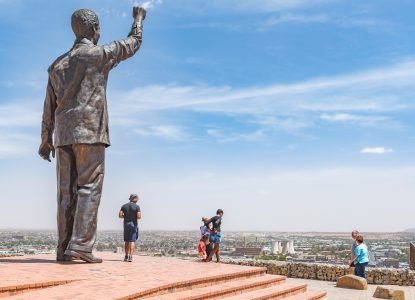By Milton Allimadi
– – –

I was about 12 when I started reading Western newspapers and magazines at the U.S. Information Services library, while growing up in Tanzania—my family had fled there from Uganda to escape the notorious dictator, Gen. Idi Amin. Even as a youngster, I was appalled that Africans and people of African descent were always depicted as the “other”; as “tribal” peoples, somehow inferior to Europeans.
Many years later, when I’d moved to the U.S., I recall sitting in a Freshman English class at Syracuse University where the professor effusively read passages from Joseph Conrad’s “Heart of Darkness”—passages where African characters were depicted as bestial and cannibalistic. The professor claimed the novel was perhaps “the best book ever written in the English language.” Yet, at the time, I wasn’t intellectually equipped to refute the professor.
A Journey of Research
It was years later, while attending the Graduate School of Journalism at Columbia, that I decided to embark on a research journey to trace the representations of Africans in Western media for my Masters thesis.
How did the Europeans who first encountered Africans centuries ago depict them in their writings? What were their motives? How have those initial representations shaped perception towards Africans and their descendants? Over the years, I continued the research, culminating in the publication last year of my book, “Manufacturing Hate, How Africa Was Demonized in Western Media.”
My work shows how racist depictions of Africans—and other non-European people—historically went hand-in-hand with conquest, domination, and economic exploitation. Racism became institutionalized; and even “manufactured,” or manipulated, to promote domination over non-Europeans. It was used to depict non-Europeans, including Africans, as less than human, to make it easier for their exploitation to become acceptable.
Demonization for Conquest
Africans were often compared, unfavorably, to animals. Samuel Baker, one of the early European so-called “explorers” who traveled to Africa in the 19th century, wrote in his 1866 book, Albert Nyanza:
“I wish the black sympathizers in England could see Africa’s inmost heart as I do, much of their sympathy would subside … Human nature viewed in its crude state as pictured amongst African savages is quite on a level with that of the brute, and not to be compared with the noble character of the dog.”
The demonization was a mask for imperial economic conquest; profit was the prime motive. “England, the great chief of the commercial world, possesses a power that enforces a grave responsibility. She has the force to civilize. She is the natural colonizer of the world,” Baker wrote.
Fabrication and Adopted Narratives
The so-called “explorers” even encouraged their peers to fabricate incidents that would depict Africans as backward people. John Hanning Speke, author of the 1863 book Journal of The Discovery of the Source of the Nile, advised John Petherick, a contemporary traveler, to write a book “loaded with amusing anecdotes and fights with the natives: the thing would tell admirably just at present, and for the future would keep the world looking anxiously for your peregrination.”
Major newspapers adopted the narrative created by the “explorers”: that the “barbarians” needed European colonization.
“There is an old touch, a tertiary or pre-tertiary touch about them, affiliating them with the ancient hippopotamus and the crocodile; but there is also a touch of a sensitiveness and an affection as keen as any to which the more civilized races have attained,” was how The New York Times described Africans in an editorial on July 1, 1877. “Surely this is a case where the introduction of European civilization would be most justifiable, and might well repay the cost…”
European Invasion, Colonization, Brutality, and Exploitation
This was now the late 19th century, and European powers were hungry for resources from Africa to fuel their factories following the industrial revolution. In order to avoid intra-European wars during this “Scramble for Africa,” Germany’s Chancellor Bismarck organized the Berlin Conference from November 1884 to February 1885, where the entire African continent was divided up amongst the European powers.
Many African leaders fought the European invasion. Ultimately, Ethiopia was the only African country never to be colonized after it destroyed an invading Italian army on March 1, 1896 at the Battle of Adwa. The Italian military commander had vowed to return to Rome with Menelik II, the Ethiopian emperor, in a cage.
While claiming to spread Christianity and civilization, the Europeans imposed the most barbaric regimes in Africa. During Belgian King Leopold II’s reign, an estimated 10 million Congolese perished in the colonial holocaust. His military cut off the hands of Congolese men, women, or children who didn’t produce enough rubber. The punishment was meant to force others to produce more. There are infamous photos in history books showing Congolese holding up their severed hands and feet.
In South Africa, decades of racist white minority rule became an official policy known as Apartheid in 1948. Europeans made up about 10% of the population, but controlled about 80% of the land and all of the wealth from the country’s gold and diamonds. The Europeans who imposed Apartheid—descendants of Dutch invaders—invoked the biblical curse of Ham to justify the oppression of Africans; once again, demonization used to rationalize economic exploitation.

Attitudes Towards Decolonization
European colonial rule in Africa lasted from the 1890s right until 1994—even though most African countries won independence in the 1960s—when South Africa elected Nelson Mandela as the first African president a few years after he’d been released from a 27-year incarceration for fighting against Apartheid.
When decolonization from European rule appeared imminent in Africa (after Ghana, led by Kwame Nkrumah, won its independence from Britain in 1957) Western media, including The New York Times, started sending reporters to capture this momentous transition. Yet, their coverage was based on the racist template that had long been established by the writings of the so-called “explorers.”
Moreover, the European countries did not want to part with their colonial possessions—so media coverage gave the impression that Africans were undeserving of independence and didn’t even know what it meant.
The Coverage of Homer Bigart
In late 1959, The New York Times sent Homer Bigart, a famous reporter who’d already won two Pulitzer Prizes, to cover decolonization in Africa. “I’m afraid I cannot work up any enthusiasm for the emerging republics,” Bigart wrote in an undated letter to Emmanuel Freedman, The New York Times foreign news editor, from Africa. “The politicians are either crooks or mystics. Dr. Nkrumah is a Henry Wallace in burnt cork. I vastly prefer the primitive bush people. After all, cannibalism may be the logical antidote to this population explosion everyone talks about.” (Nkrumah was Ghana’s prime minister, whom Bigart suggested was a black-face version of a white American politician).
The racism expressed by Bigart was promoted by his editor, Freedman, and it was also conveyed in the articles he wrote. Bigart’s favorite terms for describing the Africans were “barbaric,” “macabre,” “grotesque,” and “savage.” One of his articles was published on January 31, 1960, under the ugly headline “Barbarian Cult Feared in Nigeria.” Bigart wrote that, “A pocket of barbarism still exists in eastern Nigeria, despite some success by the regional government in extending a crust of civilization over the tribe of the pagan Izi.”
He added, “A momentary lapse into cannibalism marked the closing days of 1959, when two men killed in a tribal clash were partly consumed by enemies in the Cross River country below Obubra. Garroting was the society’s favored method of execution.”
Even though Bigart had alleged cannibalism, the same article contradicted his claim, adding, “None of the victims was eaten, at least not by society members. Less lurid but equally effective ways were found to dispose of them. According to the police, about twenty-six were weighed with stones and timber and thrown into flooded rivers. No trace has been found of these bodies. A few were buried in ant heaps. But most became human fertilizer for the yam crops.”
Editorial Support for Racist Portrayals
Freedman, the foreign news editor, was elated. “This is just a note to say hello and to tell you how much your peerless prose from the badlands is continuing to give us and your public,” Freedman wrote to Bigart in Africa, in a letter dated March 4, 1960. “By now you must be American journalism’s leading expert on sorcery, witchcraft, cannibalism and all the other exotic phenomena indigenous to darkest Africa. All this and nationalism too! Where else but in The New York Times can you get all this for a nickel?”
In May 1960, Bigart traveled to what was then Belgian Congo, now the Democratic Republic of Congo.
“I had hoped to find pygmies voting and interview them on the meaning of independence but they were all in the woods,” Bigart complained in a letter to Freedman, on May 29, 1960. (Pygmies are diminutive Congolese and one of the most maligned Africans in Western literature).
Yet, even though Bigart expressed disappointment in not being able to interview Pygmies, by the time his article was published in the Times on June 5, 1960, under the contemptuous headline, “Magic of Freedom Enchants Congolese,” Bigart was informing American readers that the Congolese, Pygmies especially, didn’t really understand the magnitude of the occasion.
“As the hour of freedom from Belgian rule nears, In-de-pen-dence is being chanted by Congolese all over this immense land, even by pygmies in the forest,” Bigart’s article stated. “Independence is an abstraction not easily grasped by Congolese and they are seeking concrete interpretations,” Bigart claimed, uncaring of the country’s brutal Belgian colonial history under Leopold II. “To the forest pygmy independence means a little more salt, a little more beer…”
Fabrication to Fit an Image
The New York Times had become so vested in publishing racist caricatures of Africans that when the facts did not match the agenda, the editors took matters into their own hands. One New York Times reporter, Loyd Garrison—a descendant of the 19th century American abolitionist William Lloyd Garrison—was shocked by a fabrication inserted into a story he’d filed from Nigeria, where he was covering the civil war in the 1960s. “The reference to ‘small pagan tribes dressed in leaves’ is slightly misleading and could, because of its startling quality, give the reader the impression that there are a lot of tribes running around half-naked,” Garrison complained, rather diplomatically, in a letter dated June 5, 1967. In other words, Garrison had not written anything about “small pagan tribes dressed in leaves” in his story, but the editors, to fulfill their own craving for a “savage” image of Nigeria, had manufactured the description from thin air.
Garrison also complained that the words “tribes” and “tribesmen” had been inserted into his articles in the past.
“’Tribesmen’ connote the grass-leaves image,” he wrote. “Plus, the word ‘tribes’ equals primitive, which in a country like Nigeria just doesn’t fit, and is offensive to African readers who know damn well what unwashed American and European readers think when they stumble on the word…”

Fostering Inferiority Complexes in Those of African Descent
Centuries of demonization of Africa created the pervasive racist perception of Africans. It promoted white supremacy while also fostering inferiority complexes in Africans and descendants of Africa. In a speech delivered in Detroit, Michigan, on February 14, 1965, Malcolm X spoke about the impact of demonization of Africans on African Americans:
“…the colonial powers of Europe, having complete control over Africa, they projected the image of Africa negatively. They projected Africa always in a negative light: jungles, savages, cannibals, nothing civilized. Why then naturally it was so negative it was negative to you and me, and you and I began to hate it. We didn’t want anybody to tell us anything about Africa, much less calling us ‘Africans.’ In hating Africa and hating the Africans, we ended up hating ourselves, without even realizing it. Because you can’t hate the roots of a tree and not hate the tree. You can’t hate your origin and not end up hating yourself.”
“Ooga-Booga” Journalism
Many years ago, on January 12, 1992, when I’d first started my research, I interviewed Michael T. Kaufman, who at the time was the deputy foreign news editor of The New York Times. He’d once been a foreign correspondent based in Nairobi, Kenya, during the 1970s, and he spoke candidly about his experience writing about Africa. Kaufman recalled that while he was in Kenya, he favored two types of approaches to African coverage. One was a thematic style, writing articles that were relevant across national borders; the other was “ooga-booga” journalism:
“When I was growing up and Tarzan was about to attack Africans, they would make him speak his fake African, ‘ooga-booga, ooga-booga,’” Kaufman, who was white, explained. “That’s what I call ooga-booga reporting. It is the National Geographic approach. It captures the thing that is unique to the place. Ooga-booga stories are titillating. I enjoyed them, as did the readers too,” he said.
What is to be Done?
How far have we traveled in terms of the perception of Africans? Where do we go? What is to be done?
We need to have more events like the “Racism In The Media” webinar organized on January 20, 2022 by the G20 Interfaith Forum, in which I participated with three other panelists. (Click here for the video recording; click here for the written summary).
We need to form political alliances between people of color and include low-income European Americans. It’s often the rich elite who keep us divided by promoting racism in order to divert the conversation away from critical conversations such as the nation’s intolerable wealth inequality.
We also need to turn controversy into teachable moments.
Turning Controversy into Teachable Moments
Recently, Joe Rogan, host of the popular “The Joe Rogan Experience,” found himself dealing with strong backlash after he made comments about Africa and race-matters. Rogan criticized a prominent African American professor at Vanderbilt University, Michael Eric Dyson, who’d referred to Rogan’s guest on the show as an “angry white man.” Rogan then claimed Dyson himself didn’t even have the right to call himself “Black” since he was “brown.” Rogan claimed the only people really entitled to be called Black were “like 100% African from the darkest place where they’re not wearing any clothes all day and they developed all that melanin to protect themselves from the sun.”
I decided to use the incident as a teachable moment—which is something we should all do whenever we can—and wrote an article in the The New York Daily News on February 2, 2022, which ran under the headline “Joe Rogan’s not Black — or is he?”
I wrote that regardless of our current “race”—which itself is a social construct— we all hail from common ancestors: the first human beings who originated in East and Central Africa. We all have very much in common. I concluded my article by stating:
“It’s foolish for people to focus so much on our superficial different appearances…however, we must acknowledge, and address the fact that the false notion of white supremacy has destroyed many lives — and continues to do so.”
Our work to combat manufactured racism must never stop. That’s the only way we can create a better world for the next generation—by helping to diminish the toxicity of racism.
– – –
Allimadi is an Adjunct Assistant Professor of Journalism at the Graduate School of Journalism at Columbia; and Adjunct Assistant Professor of African History at John Jay College. He’s publisher of www.BlackStarNews.com and author of “Manufacturing Hate, How Africa Was Demonized in Western Media,” which forms the foundation of this article.


